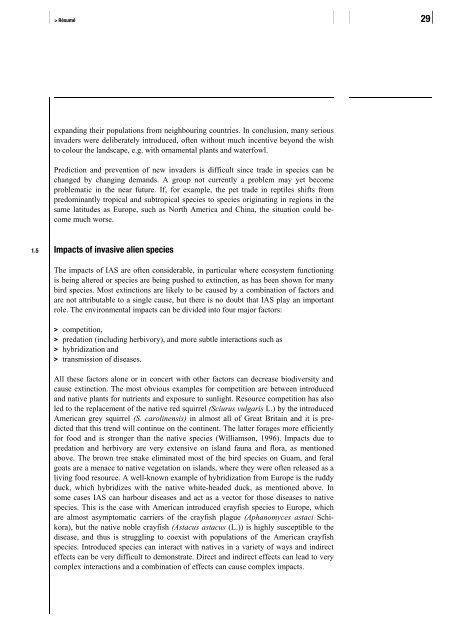Invasive alien species in Switzerland - Schweizer ...
Invasive alien species in Switzerland - Schweizer ...
Invasive alien species in Switzerland - Schweizer ...
Create successful ePaper yourself
Turn your PDF publications into a flip-book with our unique Google optimized e-Paper software.
Résumé 29<br />
expand<strong>in</strong>g their populations from neighbour<strong>in</strong>g countries. In conclusion, many serious<br />
<strong>in</strong>vaders were deliberately <strong>in</strong>troduced, often without much <strong>in</strong>centive beyond the wish<br />
to colour the landscape, e.g. with ornamental plants and waterfowl.<br />
Prediction and prevention of new <strong>in</strong>vaders is difficult s<strong>in</strong>ce trade <strong>in</strong> <strong>species</strong> can be<br />
changed by chang<strong>in</strong>g demands. A group not currently a problem may yet become<br />
problematic <strong>in</strong> the near future. If, for example, the pet trade <strong>in</strong> reptiles shifts from<br />
predom<strong>in</strong>antly tropical and subtropical <strong>species</strong> to <strong>species</strong> orig<strong>in</strong>at<strong>in</strong>g <strong>in</strong> regions <strong>in</strong> the<br />
same latitudes as Europe, such as North America and Ch<strong>in</strong>a, the situation could become<br />
much worse.<br />
1.5 Impacts of <strong>in</strong>vasive <strong>alien</strong> <strong>species</strong><br />
The impacts of IAS are often considerable, <strong>in</strong> particular where ecosystem function<strong>in</strong>g<br />
is be<strong>in</strong>g altered or <strong>species</strong> are be<strong>in</strong>g pushed to ext<strong>in</strong>ction, as has been shown for many<br />
bird <strong>species</strong>. Most ext<strong>in</strong>ctions are likely to be caused by a comb<strong>in</strong>ation of factors and<br />
are not attributable to a s<strong>in</strong>gle cause, but there is no doubt that IAS play an important<br />
role. The environmental impacts can be divided <strong>in</strong>to four major factors:<br />
> competition,<br />
> predation (<strong>in</strong>clud<strong>in</strong>g herbivory), and more subtle <strong>in</strong>teractions such as<br />
> hybridization and<br />
> transmission of diseases.<br />
All these factors alone or <strong>in</strong> concert with other factors can decrease biodiversity and<br />
cause ext<strong>in</strong>ction. The most obvious examples for competition are between <strong>in</strong>troduced<br />
and native plants for nutrients and exposure to sunlight. Resource competition has also<br />
led to the replacement of the native red squirrel (Sciurus vulgaris L.) by the <strong>in</strong>troduced<br />
American grey squirrel (S. carol<strong>in</strong>ensis) <strong>in</strong> almost all of Great Brita<strong>in</strong> and it is predicted<br />
that this trend will cont<strong>in</strong>ue on the cont<strong>in</strong>ent. The latter forages more efficiently<br />
for food and is stronger than the native <strong>species</strong> (Williamson, 1996). Impacts due to<br />
predation and herbivory are very extensive on island fauna and flora, as mentioned<br />
above. The brown tree snake elim<strong>in</strong>ated most of the bird <strong>species</strong> on Guam, and feral<br />
goats are a menace to native vegetation on islands, where they were often released as a<br />
liv<strong>in</strong>g food resource. A well-known example of hybridization from Europe is the ruddy<br />
duck, which hybridizes with the native white-headed duck, as mentioned above. In<br />
some cases IAS can harbour diseases and act as a vector for those diseases to native<br />
<strong>species</strong>. This is the case with American <strong>in</strong>troduced crayfish <strong>species</strong> to Europe, which<br />
are almost asymptomatic carriers of the crayfish plague (Aphanomyces astaci Schikora),<br />
but the native noble crayfish (Astacus astacus (L.)) is highly susceptible to the<br />
disease, and thus is struggl<strong>in</strong>g to coexist with populations of the American crayfish<br />
<strong>species</strong>. Introduced <strong>species</strong> can <strong>in</strong>teract with natives <strong>in</strong> a variety of ways and <strong>in</strong>direct<br />
effects can be very difficult to demonstrate. Direct and <strong>in</strong>direct effects can lead to very<br />
complex <strong>in</strong>teractions and a comb<strong>in</strong>ation of effects can cause complex impacts.
















